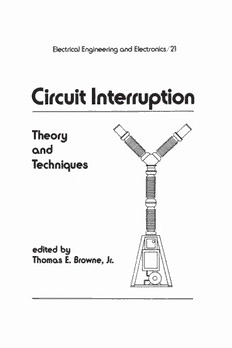
Circuit interruption: theory and techniques PDF
Preview Circuit interruption: theory and techniques
CIRCUIT INTERRUPTION ELECTRICAL ENGINEERING AND ELECTRONICS A Series of Reference Books and Textbooks Editors Marlin 0. Thurston William Middendorf Department of Electrical Department of Electrical Engineering and Computer Engineering The Ohio State University University of Cincinnati Columbus, Ohio Cincinnati, Ohio 1. Rational Fault Analysis, edited by Richard Saeks and S. R. Liberty 2. Nonparametric Methods in Communications, edited by P. Papantoni- Kazakos and Dimitri Kazakos 3. Interactive Pattern Recognition, Yi-tzuu Chien 4. Solid-State Electronics, Lawrence E. Mu" 5. Electronic, Magnetic, and Thermal Properties of Solid Materials, Klaus Schroder 6. Magnetic-Bubble Memory Technology, Hsu Chang 7. Transformer and Inductor Design Handbook, Colonel Wm. T. McLyman 8. Electromagnetics: Classical and Modern Theory and ApplicatioJ1S, Samuel Seely and Alexander D. Poularikas 9. One-Dimensional Digital Signal Processing, Chi-Tsong Chen I 0. Interconnected Dynamical Systems, Raymond A. DeCarlo and .Richard Saeks 11. Modern Digital Control Systems, Raymond G. Jacquot 12. Hybrid Circuit Design and Manufacture, Roydn D. Jones 13. Magnetic Core Selection for Tranformers and Inductors: A User's Guide to Practice and Specification, Colonel Wm. T. McLyman 14. Static and Rotating Electromagnetic Devices, Richard H. Engelmann 15. Energy-Efficient Electric Motors: Selection and Application, John C. Andreas 16. Electromagnetic Com possibility, Heinz M. Schlicke 17. Electronics: Models, Analysis, and Systems, James G. Gottling 18. Digital Filter Design Handbook, Fred J. Taylor 19. Multivariable Control: An Introduction, P. K. Sinha 20. Flexible Circuits: Design and Applications, Steve Gurley, with contributions by Carl A. Edstrom, Jr., Ray D. Greenway, and William P. Kelly 21. Circuit Interruption: Theory and Techniques, edited by Thomas E. Browne, Jr. Other Volumes in Preparation CIRCUIT INTERRUPTION Theory and Techniques Edited by THOMAS E. BROWNE, JR. Westinghouse Research and Development Center Pittsburgh, Pennsylvania n MARCEL MARCEL DEKKER, INc. NEw YoRK· BASEL DEKKER Library of Congress Cataloging in Publication Data Main entry under title: Circuit interruption. (Electrical engineering and electronics; 21) Includes index. 1. Electric circuit-breakers. 2. Electric arc. 3. Electric contacts. I. Browne, Thomas E. [date] II. Series. TK2842.C57 1984 621.31'7 84-12087 ISBN 0-8247-7177-X Copyright© 1984 by Marcel Dekker, !nc. All Rights Reserved Neither this book nor any part may be reproduoed or transmitted in any form or by any means, eleotronic or mechanical, including photocopying, microfilming, and recording, or by any information storage and retrieval system, without permission in writing from the publisher. Marcel Dekker, Inc. 270 Madison Avenue, New York, New York 10016 Current printing (last digit) : 10 9 8 DEDICATED to the memory of Joseph Slepian Teacher, Inventor and Pioneer in Furthering the Understanding of Circuit-Interrupting Devices Preface In the early growth of electric power systems, there was fairly complete understanding of mechanical and electromagnetic theory as applied to rotating machinery. The circuit -interrupting devices, however, were developed by "cut and try" methods and they all relied on the some- what mysterious properties of the electric arc to switch the current. As short-circuit currents increased, some of the interrupting failures were quite spectacular. As an indication of the early state of the theory, while a young engineer I was told by an experienced breaker designer that oil circuit breaker ratings could be increased mainly by making the tanks stronger! Although patent records show much ac- tivity in circuit breaker development around the beginning of this century, it was only in the 1920s (see Chapter 1) that worldwide re- search began to solve some of the mysteries of high-power circuit in- terruption. Since then an imposing amount of published literature on arc interruption in circuit breakers has emerged, but relatively few books have been written on the subject (see Chapter 1, General References). The aim of this book is to provide information to practicing engi- neers and students about the history and current state of circuit in- terruption theory and techniques by drawing on the knowledge and experience of twenty-two contributors who are or have recently been actively involved in research, development, or application of modern circuit breakers. The large number of contributors reflects the great diversity that characterizes the circuit interruption field today. Even in this book, oil and compressed-air circuit breakers are not covered because they are being superseded by the sulfur hexafluoride (SFa) puffer breaker (Chapter 10). Power fuses are also not included since developments in the theory of these devices have not been ex- tensive. Because of the emphasis on physical principles, no attempt has been made to furnish complete descriptions of all presently manufac- v
